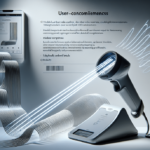How to Connect, Optimize, and Manage UDS for Barcode Scanners
Barcode scanning technology has revolutionized business operations by streamlining inventory tracking, asset monitoring, and supply chain management. A pivotal element in these systems is the Universal Data Solution (UDS). This guide delves into the role of UDS in barcode scanning, detailed steps to connect your scanner to UDS, and strategies to optimize and manage UDS for enhanced business efficiency.
Understanding UDS and Its Role in Barcode Scanning
Universal Data Solution (UDS) serves as an intermediary between barcode scanners and backend applications, facilitating seamless data flow and integration. By configuring scanner settings and managing data transmission, UDS ensures that scanned information is accurately captured and processed.
- Real-Time Data Visibility: UDS enables immediate transmission of scanned data, allowing businesses to monitor inventory and assets in real-time.
- Versatility: Supports various barcode types, including 1D, 2D, and QR codes, catering to diverse business needs.
- Integration: Bridges communication between scanners and enterprise systems like ERP and WMS, enhancing operational workflows.
According to a Forrester report, implementing UDS can improve data accuracy by up to 99%, significantly reducing errors in inventory management.
Connecting Your Barcode Scanner to UDS
Establishing a connection between your barcode scanner and UDS involves several key steps:
- Verify Compatibility: Ensure your barcode scanner is compatible with UDS by consulting the manufacturer's documentation or support.
- Network Connection: Connect the scanner to your network via Ethernet or Wi-Fi, depending on the device's capabilities.
- Configure Scanner Settings: Adjust settings to enable UDS connectivity, which may include setting network protocols and data formats.
- Install UDS Software: Deploy the UDS software on your backend systems, following the installation guidelines to ensure proper integration.
In industries like retail and logistics, successful integration of UDS with barcode scanners can lead to a 30% increase in scanning efficiency, as reported by the Supply Chain Digital.
Optimizing and Managing UDS for Efficient Barcode Scanning
Configuring Scanner Settings
Adjusting scan parameters such as scan mode, speed, and barcode type is essential for optimal performance. Proper configuration ensures that scanners operate efficiently and reduce the likelihood of errors.
Implementing Automatic Data Capture
Automating data capture minimizes manual entry, enhances accuracy, and speeds up operations. Features like auto-trigger scanning and batch processing can significantly improve workflow efficiency.
Real-Time Data Synchronization
Ensuring that scanned data is immediately synchronized with backend systems allows for timely inventory updates and decisions. This real-time capability is crucial for maintaining accurate stock levels and responding swiftly to market demands.
Utilizing High-Quality Barcode Labels
Investing in high-quality labels reduces scanning errors and enhances data accuracy. Poorly printed or damaged labels can lead to misreads, causing delays and inaccuracies.
Regular Maintenance and Updates
Keeping UDS software and hardware updated ensures compatibility and optimal performance. Regular maintenance routines help prevent downtime and extend the lifespan of your barcode scanning system.
Troubleshooting Common UDS Issues
Connectivity Problems
Connectivity issues between the barcode scanner and UDS can stem from network disruptions or hardware malfunctions. To resolve these:
- Check network cables and connections.
- Restart network devices and the scanner.
- Ensure that firewall settings are not blocking communication.
Configuration Errors
Mistakes in scanner or UDS configuration can hinder data transmission. Verify settings such as IP addresses, port numbers, and data formats to ensure they align with system requirements.
Synchronization Failures
Data not syncing correctly can lead to inventory discrepancies. Ensure that both the scanner and UDS are operating on the latest software versions and that there are no compatibility issues.
For further assistance, refer to the TechRepublic guide on troubleshooting barcode scanners.
Benefits and Best Practices of Using UDS for Barcode Scanning
Enhanced Accuracy and Efficiency
UDS minimizes data entry errors and accelerates the scanning process, leading to more accurate inventory management and faster operation cycles.
Improved Inventory Management
Real-time data allows businesses to maintain optimal stock levels, reduce overstocking or stockouts, and make informed purchasing decisions.
Employee Productivity Tracking
UDS can monitor employee scanning activities, helping identify training needs and optimize workforce performance.
Best Practices
- Regular Training: Ensure that staff are well-versed in using barcode scanners and UDS software.
- Routine Audits: Conduct regular system audits to identify and rectify potential issues proactively.
- Secure Data Handling: Implement security protocols to protect sensitive data captured through barcode scanning.
Implementing these best practices can lead to a 20% improvement in operational efficiency, as highlighted by the Business.com analysis.
Alternative Solutions to UDS for Barcode Scanning
While UDS is a robust solution, businesses may explore alternatives based on specific needs:
- Cloud-Based Barcode Scanning: Offers scalability and accessibility, allowing data to be accessed from anywhere with an internet connection.
- Mobile Barcode Scanning: Utilizes smartphones or tablets for scanning, providing flexibility and mobility.
- Standalone Barcode Systems: Dedicated scanners for specific applications, such as point-of-sale systems, offering high-speed and accuracy.
Each alternative has its advantages and trade-offs. For instance, cloud-based solutions require reliable internet connectivity, while mobile scanning may sacrifice some accuracy compared to dedicated systems. Businesses should evaluate their operational requirements and choose the solution that best aligns with their goals.
Best Practices for Maintaining UDS and Your Barcode Scanner
Regular Cleaning and Maintenance
Keep barcode scanners free from dust and debris to ensure optimal performance. Regular cleaning prevents hardware malfunctions and extends the device's lifespan.
Preventive Maintenance Schedule
Implement a schedule for regular checks and maintenance tasks, such as updating software, inspecting cables, and testing scanner functionality.
System Backups
Maintain regular backups of UDS configurations and data to prevent loss in case of hardware failures or data breaches.
Employee Training
Educate employees on proper handling and usage of barcode scanners, including safe storage and operation techniques to minimize wear and tear.
Adhering to these maintenance practices ensures that your barcode scanning system remains reliable and efficient, reducing downtime and maintenance costs.
Exploring Alternative Solutions to UDS for Barcode Scanning
While UDS offers comprehensive solutions for barcode scanning integration, alternative systems may better suit specific business needs:
- Cloud-Based Systems: Ideal for businesses requiring scalable solutions with remote access capabilities.
- Mobile Scanning: Suitable for on-the-go operations, allowing data capture via mobile devices.
- Standalone Systems: Best for high-volume environments like retail checkouts, where speed and reliability are paramount.
Choosing the right system involves assessing factors such as operational scale, required features, and budget constraints. Consulting industry reports from sources like McKinsey & Company can provide valuable insights into the latest trends and solutions in barcode scanning technology.
How to Troubleshoot UDS Connectivity Issues with Your Barcode Scanner
Connectivity issues between UDS and barcode scanners can disrupt operations. Follow these troubleshooting steps to resolve common problems:
- Check Network Connectivity: Ensure that both the scanner and UDS are connected to the network. Verify IP addresses and network settings.
- Verify Scanner and UDS Settings: Confirm that the configuration settings on both devices match and are correctly set up for communication.
- Update Firmware: Ensure that both the barcode scanner and UDS software are running the latest firmware and software updates.
- Reset Devices: Restart the barcode scanner and UDS to refresh connections and clear temporary glitches.
If issues persist, consult the manufacturer's support or seek assistance from a technical expert. Implementing a secondary UDS system or alternative scanning solutions can provide backup options to maintain operational continuity.
Additionally, consider environmental factors that might affect connectivity, such as physical obstructions or wireless interference. Positioning devices closer together and minimizing obstacles can enhance signal strength and reliability.
Conclusion
Universal Data Solution (UDS) is integral to modern barcode scanning systems, enabling seamless data integration and enhancing operational efficiency. By understanding how to connect, optimize, and manage UDS, businesses can leverage barcode technology to improve accuracy, streamline inventory management, and boost productivity. Implementing best practices and staying informed about alternative solutions ensures that your barcode scanning infrastructure remains robust and adaptable to evolving business needs.






















